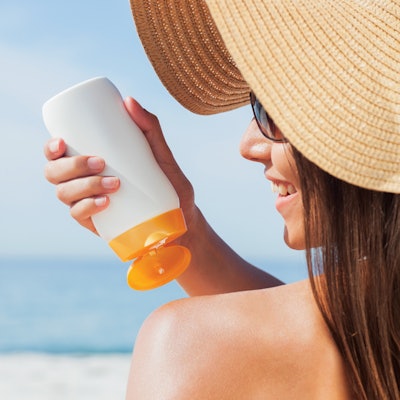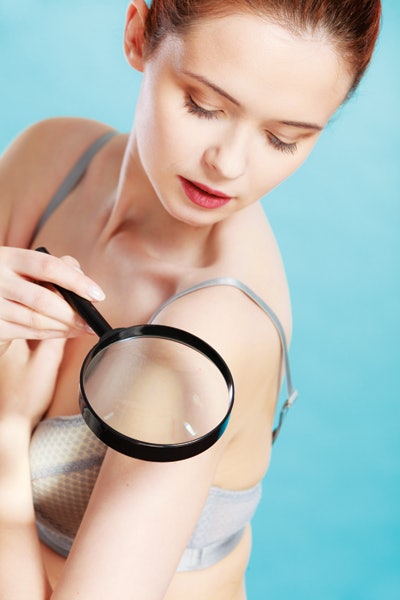 [Images: Getty Images]
[Images: Getty Images]With the ozone diminishing, the planet warming, and the American Academy of Dermatology (AAD) estimating that one in five Americans will develop skin cancer during their lifetime, the onus is increasingly on skincare professionals to guide the less-than-sun-smart masses. With most people applying only 25 to 50 percent of the AAD’s recommended amount of sunscreen, and plenty of misinformation swirling around about whether or not a daily SPF is even necessary for all skin types, you’ve got your work cut out. Which is why, for Melanoma Awareness Month, DAYSPA asked a panel of seasoned professionals and dermatologists some common sun-care questions to help pinpoint the best ways to protect oneself—and relay this crucial information to clients.
What’s the difference between physical and chemical sunscreens, and is one more effective than the other?
Doris Day, MD, owner of Day Dermatology & Aesthetics, New York City: Chemical is considered organic and physical is considered inorganic, oddly enough. I use both.
Chris Birchby, founder of COOLA: Classic sunscreens use chemical active ingredients designed to absorb and dissipate UVA/UVB rays, while physical—or mineral—sunscreens use mineral active ingredients such as titanium dioxide and zinc oxide to scatter and reflect UVA/UVB rays. Chemical sunscreens should be applied at least 15 minutes before sun exposure, while mineral sunscreens are effective right after application.
David J. Leffell, MD, professor of dermatology and dermatologic surgery chief, Yale School of Medicine, New Haven, Connecticut: They’re equally effective. Physical sunblocks literally block UVA/UVB rays by acting like little mirrors. Sunscreens absorb UV radiation.
Charlene DeHaven, MD, clinical director of Innovative Skincare: The advantage of physical sunblocks is that they’re inert; i.e., they don’t interact with skin, so there’s no risk of skin sensitivity or solar hypersensitivity—an extreme inflammatory response—as there is with chemical sunscreens. The potential disadvantage of physical sunscreens? The inexpensive varieties are opaque and non-beautiful. Newer, micro-encapsulated physical sunscreens are transparent and can be used under makeup, but they’re more expensive. The advantage of chemical sunscreens is that they’re cheaper to make.
RELATED: Spa Pros Reveal the Best Treatments and Ingredients for Dry Skin
Ali Hendi, MD, skin cancer specialist at Mohs & Dermatologic Surgery, Chevy Chase, Maryland: Both are effective, although UVA (the ‘aging’ rays, as opposed to UVB, the ‘burning’ rays) are better blocked by some chemical sunscreens, whereas physical sunscreens tend to stay on the skin longer.

Dr. Leffell: The most frequently recommended SPF number is 30, which blocks about 96 percent of UVA/UVB rays. Above that, the percentage of effectiveness drops, meaning that at SPF 60—which you’d think would be twice as effective as SPF 30— you’re actually only getting a slight percentage more protection.
Dr. DeHaven: For chemical sunscreens, using an SPF above 30 can raise the risks of irritation and skin sensitivity.
Dr. Day: Under SPF 30 is OK, but under 15, companies can’t claim that they’re reducing premature aging—just that they’re reducing the risk of burning.
Dr. Hendi: The main point isn’t how high the SPF is, but how often it’s applied. You’re better off using 30 and reapplying every two to three hours than using SPF 100 once with the false belief that it’ll protect you all day.
Is it true that some sunscreen ingredients can penetrate the bloodstream, and may even cause skin cancer?
Dr. Leffell: No! Big myth. We hear this every year from advocacy groups and although it’s true that metabolites of some of the compounds enter the bloodstream, there’s no proof that those compounds cause cancer in humans. This is the case with other personal care products as well.
Dr. Day: Groups come up with these claims, and it’s irresponsible because we know that sun exposure causes cancer. In the U.S., sunscreens are considered drugs, so the Food and Drug Administration (FDA) has to determine that all ingredients are safe to use—and the FDA has such rigorous and complicated testing that it hasn’t approved a new sun protection ingredient in 20 years. In Europe, conversely, sunscreen is regulated as a cosmetic product, so there are lots of other ingredients at play.
RELATED: The Benefits of Mud and Clay in the Treatment Room
Dr. Hendi: The few studies that have raised concerns about sunscreens’ safety have involved rats being fed sunscreen—which is not how it should be used.
Do clients with every skin tone require daily sunscreen?
Dr. Day: I’ve seen cancer in every skin tone. Tanning counts as burning! The reality is that the World Health Organization has deemed UVA/UVB rays to be known carcinogens—anyone exposed to enough of them will develop cancer or signs of premature aging.
Dr. DeHaven: Even the darkest skin tones only have an equivalent SPF of 2 to 6, at best. People who don’t experience sunburn do incur subvisual inflammation over years of sun exposure and, hence, increased rates of skin cancer and photoaging.
What are the most important sun-care tips a skin therapist can offer clients?
Dr. DeHaven: No one—no one—should skip wearing sun protection. Use a good one every day—preferably containing additional antioxidants and protectants.
RELATED: Proper Skin Cleansing Advice for Your Clients
Dr. Leffell: Tell clients to reapply throughout the day, especially if they’re active (apply every two hours when outdoors). Use enough to coat evenly—if they burn or tan
despite wearing sunscreen, they’re not using enough. They should also try to avoid the sun during peak midday hours—11:00 a.m. to 3:00 p.m., more or less—and wear a brimmed hat, and clothing with ultraviolet protection factor (UPF).
Dr. Hendi: Inform them that sunscreen is only one means of being sun safe. Often overlooked practices include wearing UPF-rated clothing, sunglasses and hats. For young children, I recommend physical/mineral sunscreen such as zinc or titanium. Remind everyone not to forget ears, lips, and toes when applying!
Birchby: Emphasize that prevention is easy, but that once skin is harmed from the sun’s rays, it’s impossible to go back.
Do you use different verbiage to caution women vs. men about the sun’s power?
Dr. DeHaven: Men are more solution-focused, and in later years will respond to the risk of skin cancer. Women respond to graphic messages about wrinkling, hyperpigmentation, sagging, etc.
Dr. Day: I always tell women, ‘Perfect your pale’—and then I show them elegant bronzers and talk about spray tans. I wish more day spas would sell sun-protective clothing.
Birchby: We appeal to men with ‘sport’ edition sunscreens.
Are there any new developments in terms of UV protection?
Dr. Hendi: There are plenty of new high-tech, high-performance UPF fabrics. Wearing this clothing protects covered skin without requiring sunscreen reapplication every few hours.
Dr. DeHaven: We’re learning more about defending our skin not only from the sun, but also from a variety of environmental aggressors including pollution, blue/ high-energy visible (HEV) light, infrared light and more—and that it’s possible to include ingredients in our sunscreens that offer additional spectrums of protection.
Dr. Day: We’re getting good at mixing repair mechanisms into sunscreen to help undo sun damage. Supplements like Heliocare can help protect skin too. We’re learning that, yes, you can eat your sunscreen sometimes—that a high- antioxidant diet won’t replace the need for sunscreen, but will offer some extra inside-out support.

Beyond the Bottle
Enlighten clients with these insights and recommendations provided by the AAD.
• When applying sunscreen, follow the guideline of one ounce, enough to fill a shot glass, to cover exposed areas of the body.
• Even on cloudy days, 80 percent of the sun’s harmful UV rays can penetrate skin.
• If your shadow is shorter than you, seek shade.
• Use extra caution near water, snow and sand, as they reflect the sun’s damaging rays.
• Get vitamin D safely, via a healthy diet or supplements. Don’t seek the sun.
• Avoid tanning beds. If you want to look tan, use a self- tanning product, but continue to use sunscreen with it.
• Check your birthday suit on your birthday. If you notice anything changing, itching or bleeding, see a dermatologist. When it comes to skin cancer, early detection is everything.
– by Katie O’Reilly











